Sign Installation: Standoffs and suspension systems
by all | 31 May 2013 8:30 am
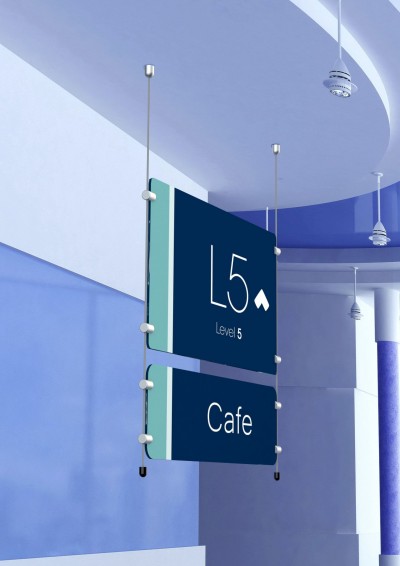 [1]
[1]Photos courtesy Fairfield Displays & Lighting
By Janice Fairfield
As the sign industry’s customers become more and more demanding, it is increasingly important for sign shops to be prepared with a toolkit of high-quality components for successful installations that will not only prove durable, but also look fantastic. This will involve keeping fully up to speed on what components are available on the market, but also ensuring they work together.
Sign installation components may look okay when listed in a brochure, only to disappoint upon delivery, with threads that are not smooth or a finish that does not meet expectations. Another common problem is a mismatch of fittings from different suppliers, which can spoil an otherwise co-ordinated design scheme.
There are different benefits to using a suspended cable or rod system or, on the other hand, standoffs. Both options have proved themselves in professional settings, but in certain circumstances, one will offer more flexibility than the other. Further, the way a sign is fixed to a wall can make a tremendous difference to its visual appearance and perceived value.
Standoffs
A standoff is simply a fixture that holds a sign away from a wall, but it can also help enhance the sign’s appearance. Standoffs can be used whenever the client wants a fixed-position sign—no matter its size or shape—mounted to a flat wall surface (or, in some cases, a desk or display unit).
Standoffs are often used in office reception areas, for example, to mount directory signage, collages of images or artwork to the wall. They are also frequently used to display large-format menus for restaurants and promotional signs for retail stores.
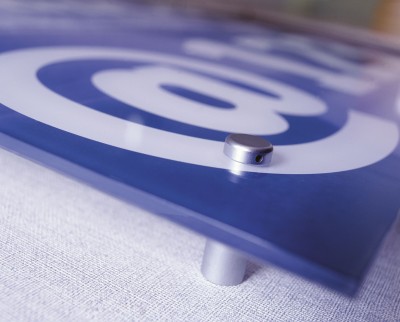 [2]
[2]A standoff is simply a fixture that holds a sign away from a wall.
One of the advantages of standoffs is they make it relatively easy to change a sign at a later date. Also, since they hold the sign away from the wall, any dust gathering on that wall will drop down behind the sign, helping it to remain clean in appearance.
The majority of standoff fittings on the market today have a small hole on the side where they can be tightened with an Allen key, making them pilfer-resistant. Another benefit of a standoff is it can be visually attractive in its own right, compared to an ordinary wall screw that becomes rusty over time.
Not all fittings are the same. Choosing the right one for the job at hand will save time and money.
Small and large signs alike can easily be accommodated, with standoffs ranging in diameter from 12 to 25 mm (0.47 to 0.98 in.) and in depth from 14 to 75 mm (0.55 to 3 in.).
Fittings can be made in two or three parts. A three-part fitting is more expensive, but the advantage is it will be much quicker and easier to fix into place.
The back section is a brass boss (i.e. protuberance), designed to be quickly and simply screwed to the wall. It will take screw threads up to 4.8 mm (0.19 in.) in diameter (i.e. ‘#10 screw’), which means a solid fixture can be achieved in a brick or concrete masonry unit (CMU) wall. The hole in the boss is big enough to allow an ‘interset’ fixture, which means the standoffs can be secure on partition walls.
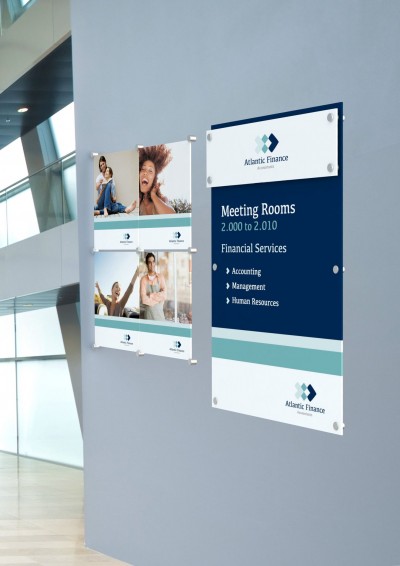 [3]
[3]Standoffs are often used in reception areas to mount wayfinding signage, images or artwork.
Another advantage for sign installers is not having to work with a screwdriver down a long barrel, where it is very difficult to see what is happening. This type of fixture is particularly useful when working on a ladder.
On some larger-diameter fittings, there is a special added ‘lip.’ This is a significant asset for an individual installer when fixing a large sign panel into place, as the lip acts as a panel locator and stops the panel from sliding down. This type of standoff will typically hold panels up to 20 mm (0.79 in.) thick.
Smaller two-part fixtures are ideal for attaching standoffs directly to wooden display panels or doors. Their hole size may vary, but normally will accommodate screw threads from 3.5 to 4.2 mm (0.14 to 0.16 in.) in diameter (i.e. #6 to #8 screws).
While the majority of panels and acrylic poster holders are mounted to walls by use of their panel holes, some standoff manufacturers provide plastic washers that can be inserted directly into fixtures, such that small signs do not need holes at all. These can be extremely useful for quick installations.
Suspension systems
Suspended cable or rod systems provide much more flexibility when installing signs. Unlike standoffs, they do not require a completely flat wall. Indeed, they do not need a wall at all.
With these systems, signs can be suspended from the ceiling, fixed between the floor and the ceiling or mounted to either a flat or curved wall. While a fixed sign must remain in place (and can leave behind an ugly hole in the wall after it is removed), a suspended sign can be positioned at any height along its vertical cables or rods.
A hanging sign can certainly be achieved with small standoffs and a ‘jaw’ clamp from the ceiling, but often the ceiling is too high for such a setup. Instead, the better option is to suspend a thin-diameter cable or rod from the ceiling. Double-sided signs can be clamped from the side, while single-sided signs can have holes drilled through, such that the rods go down the back and are held in place by studs in the front. Signs can be mounted one under the other, as the system ensures everything hangs straight, no matter each sign’s shape or size.
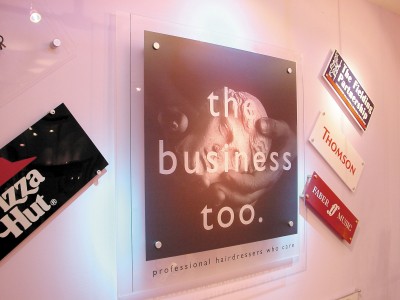 [4]
[4]Since standoffs hold signs away from the wall, any dust gathering on that wall will drop down behind, helping them to remain clean in appearance.
Labour costs are reduced with these types of systems, as it is much quicker and easier to put up multiple signs along a cable or rod system than it is to drill holes in a wall for each individual sign. Rods are typically available in several thicknesses—e.g. 3, 6 and 10 mm (0.12, 0.24 and 0.39 in.)—and a wider variety of lengths.
The design of the clamps or panel supports can be specified to match the appearance of standoffs, so a sign system can feature a totally integrated colour scheme. And like the standoffs, suspended signs can be fixed into place with an Allen key, which makes adjustments sufficiently easy for the client’s office staff or retail employees to handle in-house.
In cases where sign information is constantly being changed, one option is an acrylic pocket that allows graphics to be dropped into place, without the need for any tools. The less expensive it is to change a sign, the more opportunities there are for clients to use it as part of their business.
A directory, for example, could be installed with 6-mm (0.24-in.) diameter rods mounted to a wall or suspended in the centre of an open space. It could be single- or double-sided. Its individual sign panels could be mounted above and underneath each other, with no restrictions on panel height, so the header and footer panels might be larger than the others.
This type of directory is a good example of a system that is easy to update with the addition of new signs in the future. For clients who need signage to direct their visitors to different rooms and departments, they have a lot of flexibility to make such changes.
Materials and finishes
As mentioned, the quality of the materials and finishes used for today’s sign standoff systems and suspended cable or rod systems varies significantly, so it is important to select those that will enhance a sign’s design. They range from less expensive aluminum fittings to more elegant solid brass fittings with a satin chrome or high-gloss polished finish.
The higher-quality brass fittings with smooth threads may even come with a lifetime guarantee. Indeed, it is not unusual, after 10 years or so, to see brass standoffs outlast the signs to which they are attached.
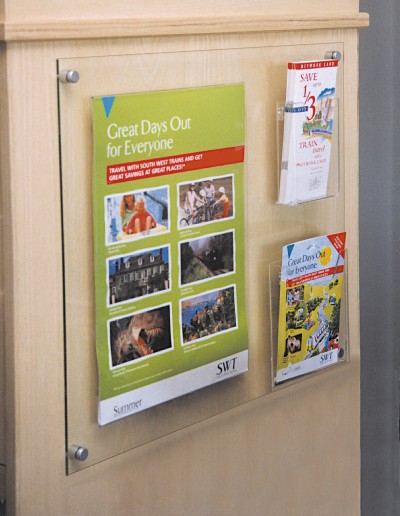 [5]
[5]Acrylic pockets allow graphics and other printed materials to be dropped into place as desired, without the need for any tools.
Less expensive aluminum standoffs and cables can provide a similar appearance to their brass counterparts, but will have a much shorter useful life and are not suitable for sign installations in moist environments, as dampness can negatively affect their threads. Even something as simple as storing a damp umbrella in an office reception area could cause a problem for nearby signs. If aluminum fittings have a manufacturer’s guarantee at all, it is typically only for one year.
In a suspended rod system, meanwhile, brushed stainless steel is preferable, since galvanized steel rods will tarnish and aluminum is not nearly as strong. The material used can thus make a big difference to the sign installation’s appearance even after just a short period.
Dimensional designs
Given how visual impact is key in creating an outstanding sign that sets the client apart from its competition, in addition to using different textures and colours of acrylic, vinyl lettering and/or full-colour digitally printed graphics, it is also worthwhile to consider how fixtures can be used to add further depth to signs.
Dimensional designs for logos and sign panels may involve joining two or three fixtures of different depths, for example, by adding special fittings that create gaps of around 6 mm (0.24 in.) between the fixtures.
It has become fashionable for signmakers to create ‘sandblasted’ effects with lettering reversed out or clear signs with dark lettering. In this case, the use of double-depth fixtures allows a solid, dark-coloured panel to be put behind the clear panel, which will soak up any unwanted shadows that would otherwise result from angling spotlights toward the display.
Cable and rod systems allow even more freedom of design. Some arrangements see several vertical graphic panels of different sizes dropped in front of each other, creating a ‘stepped’ effect.
In other cases, it may be preferable to fix several signs closely together, either as a collage or in a long line, and to reduce the number of fixtures used. In such instances, the key is to select a special fixture that can support multiple edges. It will be much more compact—and less expensive—to use one wall fixture and a multiple panel joiner, rather than several separate fixtures.
Another factor is lighting, which is becoming easier to integrate into even the most basic signage, thanks to the compact size and minimal heat generation of light-emitting diodes (LEDs). To add a touch of sparkle, they can be added behind sign panels mounted with standoffs or even clipped to cable and rod systems. An illuminated sign can be achieved at any display height, without the need for complicated wiring.
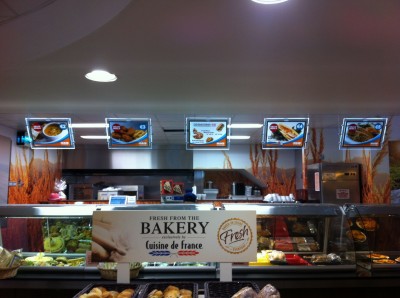 [6]
[6]As these angled, illuminated menu boards on suspended rods exemplify, lighting has become easier to integrate into slim signs, thanks to the compact size and minimal heat generation of LEDs.
- [Image]: http://www.signmedia.ca/wp-content/uploads/2014/01/P8-RB1+CG01-3.jpg
- [Image]: http://www.signmedia.ca/wp-content/uploads/2014/01/New-detail.jpg
- [Image]: http://www.signmedia.ca/wp-content/uploads/2014/01/P6.jpg
- [Image]: http://www.signmedia.ca/wp-content/uploads/2014/01/Full-Panel.jpg
- [Image]: http://www.signmedia.ca/wp-content/uploads/2014/01/Great-days-out.jpg
- [Image]: http://www.signmedia.ca/wp-content/uploads/2014/01/Light-Pocket-15.jpg
- www.fairfielddisplays.com: http://www.fairfielddisplays.com
Source URL: https://www.signmedia.ca/standoffs-and-suspension-systems/